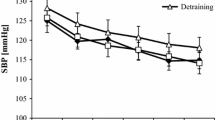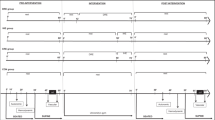Abstract
Purpose
It is well documented that post-exercise hypotension (PEH) is found both in people with borderline hypertension and in hypertensive subjects. However, PEH in normotensive individuals remains poorly understood. This study aims at analyzing the potential acute effect of a resistance training session without recovery intervals between sets and exercises in the blood pressure (BP) in normotensive elderly. We evaluated 6 elderly women with a mean age of 65 ± 3 years who had no previous history of hypertension or any cardiovascular disease. They underwent a resistance training session consisting of 3 sets of 8 maximum repetitions without recovery intervals between the sets. We measured their BP before, right after and 20 min after resistance training.
Results
There was a significant difference (p value = 0.0464) between systolic BP before the training session (mean 126.50 ± 7.34 mmHg) and 20 min after it (mean 110.16 ± 10.90 mmHg). There was no significant difference between systolic BP before the training and right after the training (mean 126.50 ± 7.34 mmHg vs. mean 129.33 ± 10.17 mmHg, p value > 0.05). We observed a significant difference between diastolic BP right after the training (mean 66.66 ± 9.09 mmHg), p value = 0.0277 and 20 min after it (mean 66.66 ± 8.93 mmHg), p value = 0.0273 when compared to the initial values (mean 71.5 ± 10.70 mmHg).
Conclusions
These findings show that there was an acute reduction in BP in the population investigated after the resistance exercise without any recovery interval.


Similar content being viewed by others
References
Giattii L, Barreto SM (2003) Saúde, trabalho e envelhecimento no Brasil. CadSaude Publica 19(3):759–771
Pugh KG, Wei JY (2001) Clinical implications of physiological changes in the aging heart. Drugs Aging 18(4):263–276
Cheitlin MD (2003) Cardiovascular physiology-changes with aging. Am J Geriatr Cardiol 12(1):9–13
Melo RC et al (2005) Effects of age and physical activity on the autonomic control of heart rate in healthy men. Braz J Med Biol Res 39(9):1331–1338
Mostarda CT, Wichi R, Sanches IC, Rodrigues B, Angelis K, Irigoyen MC (2009) Hipertensão e modulação autonômica no idoso: papel do exercício físico. Rev Bras Hipertens 16(1):55–60
Calhoun DA, Jones D, Textor S, Goff DC, Murphy TP, Toto RD et al (2008) Resistant hypertension: diagnosis, evaluation, and treatment: a scientific statement from the American Heart Association Professional Education Committee of the Council for High Blood Pressure Research. Circulation 117(25):e510–e526
Muxfeldt ES, Bloch KV, Nogueira AR, Salles GF (2003) Twenty-four hour ambulatory blood pressure monitoring pattern of resistant hypertension. Blood Press Monit 8(5):181–185
Blumenthal JA et al (2000) Exercise and weight loss reduce blood pressure in men and women with mild hypertension: effects on cardiovascular, metabolic, and hemodynamic functioning. Arch Intern Med 10(160):1947–1958
Miller ER et al (2002) Results of the diet, exercise, and weight loss intervention trial (DEW-IT). Hypertension 40:612–618
Pinto A et al (2006) Twenty-four hour ambulatory blood pressure monitoring to evaluate effects on blood pressure of physical activity in hypertensive patients. Clin J Sport Med 16:238–243
Carvalho PRC et al (2013) Efeito dos treinamentos aeróbio, resistido e concorrente na pressão arterial e morfologia de idosos normotensos e hipertensos. Rev Bras Ativ Fis Saúde Pelotas/RS 18(3):363–364
Krinsk K, Elsangedy HM, Nardo Junior N, Soares IA (2006) Efeito do exercício aeróbio e resistido no perfil antropométrico e respostas cardiovasculares de idosos portadores de hipertensão. Maringá 28(1):71–75
Stewart KJ (2005) Effect of exercise on blood pressure in older persons—a randomized controlled trial. Arch Intern Med 165:756–762
Terra DF et al (2008) Reduction of arterial pressure and double product at rest after resistance exercise training in elderly hypertensive women. Arq Bras Cardiol 91(5):274–279
Cononie CC, Graves JE, Pollock ML, Phillips MI, Sumners C, Hagberg JM (1991) Effect of exercise training on blood pressure in 70- to 79-yr-old men and women. Med Sci Sports Exerc 23(4):505–511
Van Hoof R, Macor F, Lijnen P, Staessen J, Thijs L, Vanhees L et al (1996) Effect of strength training on blood pressure measured in various conditions in sedentary men. Int J Sports Med 17:415–422
Blumenthal JA, Siegel WC, Appelbaum M (1991) Failure of exercise to reduce blood pressure in patients with mild hypertension. Results of a randomized controlled trial. Jama 266:2098–2104
Dunstan DW, Daly RM, Owen N, Jolley D, De Courten M, Shaw J et al (2002) Highintensity resistance training improves glycemic control in older patients with type 2 diabetes. Diabetes Care 25(10):1729–1736
Wood RH, Reyes R, Welsch MA, Favaloro-Sabatier J, Sabatier M, Matthew Lee C et al (2001) Concurrent cardiovascular and resistance training in healthy older adults. Med Sci Sports Exerc 33(10):1751–1758
Delmonico MJ, Ferrell RE, Meerasahib A, Martel GF, Roth SM, Kostek MC et al (2005) Blood pressure response to strength training may be influenced by angiotensinogen A-20C and angiotensin II type I receptor A1166C genotypes in older men and women. J Am Geriatr Soc 53(2):204–210
Pescatello LS, Franklin BA, Fagard R, Farquhar WB, Kelley GA, Ray CA (2004) American College of Sports Medicine position stand. Exercise and hypertension. Med Sci Sports Exerc 36:533–553
MacDonald JR (2002) Potential causes, mechanisms, and implications of post exercise hypotension. J Hum Hypertens 16:225–236
Floras JS, Sinkey CA, Aylward PE, Seals DR, Thoren PN, Mark AL (1989) Post exercise hypotension and sympathoinhibition in borderline hypertensive men. Hypertension 14(1):28–35
MacDonald JR, MacDougal JD, Hogben CD (2000) The effects of exercise duration on post-exercise hypotension. J Hum Hypertens 14:125–129
Hagberg JM, Montain SJ, Martin WH 3rd (1987) Blood pressure and hemodynamic responses after exercise in older hypertensives. J Appl Physiol 63:270–276
Rueckert PA, Slane PR, Lillis DL, Hanson P (1996) Hemodynamic patterns and duration of post-dynamic exercise hypotension in hypertensive humans. Med Sci Sports Exerc 28:24–32
Fisher MM (2001) The effect of resistance on recovery blood pressure in normotensive and borderline hypertensive women. J Strength Cond Resp 15(2):120–126
Lizardo JHF, Simões HG (2005) Efeitos de diferentes sessões de exercícios resistidos sobre a hipotensão pós-exercício. Rev Bras Fisioter 9(3):289–295
Cavalcante PA, Rica RL, Evangelista AL, Serra AJ, Figueira A Jr, Pontes FL Jr et al (2015) Effects of exercise intensity on postexercise hypotension after resistance training session in overweight hypertensive patients. Clin Interv Aging 18(10):1487–1495
Hardy DO, Tucker LA (1999) The effects of a single bout of strength training on ambulatory blood pressure levels in 24 mildly hypertensive men. Am J Health Promot 13:69–72
Maior AS, Santos FG, Freitas JGP, Pessin AC, Figueiredo T, Dias I, Salles BF, Menezes P, Simão R (2009) Efeito Hipotensivo do Treinamento de Força em Séries Contínuas e Fracionadas. Rev SOCERJ 22(3):151–157
Mutti LC, Simão R, Dias I, Figueiredo T, Salles BF (2010) Efeito Hipotensivo do Treinamento de Força em Homens Idosos. Rev Bras Cardiol 23(2):111–115
Brito AF, Oliveira CVC, Santos MSB, Santos AC (2014) Resistance exercise with different volumes: blood pressure response and forearm blood flow in the hypertensive elderly. Clin Interv Aging 9:2151–2158
Asmar R, Khabouth J, Topouchian, El Feghali R, Mattar J (2010) Validation of three automatic devices for self-measurement of blood pressure according to the International Protocol: the Omron M3 Intellisense (HEM-7051-E), the Omron M2 Compact (HEM 7102-E), and the Omron R3-I Plus (HEM 6022-E). Blood Press Monit 15(1):49–54
Eguchi K, Kuruvilla S, Ogedegbe G, Gerin W, Schwartz JE, Pickering TG (2009) What is the optimal interval between successive home blood pressure readings using an automated oscillometric device? J Hypertens 27(6):1172–1177
Lukaski HC (1999) Requirements for clinical use of bioelectrical impedance analysis (BIA). Ann N Y Acad Sci 20(873):72–76
American College of Sports Medicine (2007) Diretrizes do ACSM para os Testes de Esforço e sua Prescrição, 7 edn. Editora Guanabara Koogan
Bompa TO, Haff GG (2012) Periodização: Teoria e Metodologia do Treinamento. Editora Phorte
Cornelissen VA, Smart NA (2013) Exercise training for blood pressure: a systematic review and metaanalysis. J Am Heart Assoc 2:e004473
Roltsch MH, Mendes T, Wilund KR, Hagberg JM (2001) Acute resistive exercise does not affect ambulatory blood pressure in young men and women. Med Sci Sports Exerc 33(6):881–886
O’Connor PJ, Bryant CX, Veltri JP, Gebhardt SM (1993) State anxiety and ambulatory blood pressure following resistance exercise in females. Med Sci Sports Exerc 25(4):516–521
Hagerman FC, Walsh SJ, Staron RS, Hikida RS, Gilders RM, Murray TF et al (2000) Effects of high-intensity resistance training on untrained older men. I. Strength, cardiovascular, and metabolic responses. J Gerontol A Biol Sci Med Sci 55(7):B336–B346
Haykowsky M, Humen D, Teo K, Quinney A, Souster M, Bell G et al (2000) Effects of 16 weeks of resistance training on left ventricular morphology and systolic function in healthy men >60 years of age. Am J Cardiol 85(8):1002–1006
Yoshizawa M, Maeda S, Miyaki A, Misono M, Saito Y, Tanabe K et al (2009) Effect of 12 weeks of moderate-intensity resistance training on arterial stiffness: a randomized controlled trial in women aged 32–59. Br J Sports Med 43:615–618
Anton MM, Cortez-Cooper MY, DeVan AE, Neidre DB, Cook JN, Tanaka H (2006) Resistance training increases basal limb blood flow and vascular conductance in aging humans. J Appl Physiol 101(5):1351–1355
Taylor AC et al (2003) Isometric training lowers resting blood pressure and modulates autonomic control. Med Sci Sports Exerc 35(2):251–256
Gambassi BB, Almeida FJF, Sauaia BA, Novais TMG, Araujo AER, Chaves LFC et al (2015) Resistance training contributes to variability in heart rate and quality of the sleep in elderly women without comorbidities. JEP Online 18(6):112–123
Goto C, Higashi Y, Kimura M, Noma K, Hara K, Nakagawa K et al (2003) Effect of different intensities of exercise on endothelium-dependent vasodilation in humans: role of endothelium-dependent nitric oxide and oxidative stress. Circulation 108(5):530–535
Acknowledgments
The authors are grateful to the volunteers who participated in this study. Bruno Rodrigues received grants from the Conselho Nacional de Desenvolvimento Cientıfico e Tecnológico (BPQ-CNPq).
Author information
Authors and Affiliations
Corresponding author
Ethics declarations
Conflict of interest
The authors declare that they have no conflict of interest.
Statement of human and animal rights
All procedures performed in studies involving human participants were in accordance with the ethical standards of the institutional or national research committee and with the 1964 Helsinki declaration and its later amendments or comparable ethical standards.
Informed consent
Informed consent was obtained from all individual participants included in study.
Rights and permissions
About this article
Cite this article
Gambassi, B.B., Rodrigues, B., de Jesus Furtado Almeida, F. et al. Acute effect of resistance training without recovery intervals on the blood pressure of comorbidity-free elderly women: a pilot study. Sport Sci Health 12, 315–320 (2016). https://doi.org/10.1007/s11332-016-0290-0
Received:
Accepted:
Published:
Issue Date:
DOI: https://doi.org/10.1007/s11332-016-0290-0




